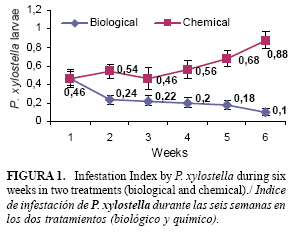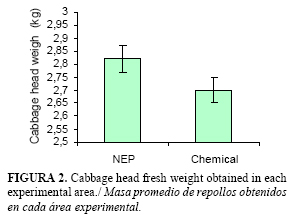Mi SciELO
Servicios Personalizados
Articulo
Indicadores
-
 Citado por SciELO
Citado por SciELO
Links relacionados
-
 Similares en
SciELO
Similares en
SciELO
Compartir
Revista de Protección Vegetal
versión impresa ISSN 1010-2752
Rev. Protección Veg. vol.28 no.2 La Habana mayo-ago. 2013
TECHNICAL NOTE
Impact of entomopathogenic nematode applications on diamond back moth population1
Impacto de aplicaciones de nematodos entomopatógenos en una población de pollilla dorso de diamante
Mayra G. RodríguezI, Roberto EnriqueI, Lucila GómezI, Dainé Hernández-OchandíaI, Ileana MirandaI, Alexei HernándezII, Luisa Díaz-VirulicheII, Esteban GonzálezI, Ligia Carolina RosalesIII
IDirección de Protección de Plantas. Centro Nacional de Sanidad Agropecuaria (CENSA). Apartado 10, San José de las Lajas. CP 32700. Mayabeque, Cuba. Email: mrguez@censa.edu.cu.
IIFacultad de Agronomía, Universidad Agraria de La Habana, Mayabeque, Cuba.
IIIInstituto Nacional de Investigaciones Agrícolas- Centro Nacional de Investigaciones Agropecuarias (INIA-CENIAP), Maracay, Venezuela.
ABSTRACT
The aim of this work was to determine the impact of entomopathogenic nematode (EPN) applications on diamond-back moth (DBM) populations and cabbage (Brassica oleraceaL.) yields in a farm of the western region of Cuba. The experiment was carried out in «Doña Amalia» Farm in the western Province of Mayabeque (Cuba). Two treatments were used: EPN (Heterorhabditis bacteriophora Pionar strain HC1) and chemical control (Clorpirifos (0,48-0,72kg ai.ha-1), both applied weekly. Each week, the DBM larvae population was evaluated. At the final of the crop, ten plants were randomly harvested from each experimental plot and the head fresh weight determined; the final yields (in t.ha-1) were calculated by the farmers. The infestation Index (referred as the mean numbers of DBM larvae for two different treatments: EPN and Chemical) over time showed statistic differences, with a low population in the biological treatment, from 0,4 larvae.plant-1 at the beginning of the experiment to 0,1 larvae.plant-1 at the end, meanwhile, in the chemical treatment, the population increased up to 0,88 larvae.plant-1, with a very high damaged crop. The head fresh weight was statistically higher in the biological treatment than in the chemical one. The total volume of production in both experimental block were 7,02t in the EPN treatment and 6,7t in the chemical block, which corresponded to 26t.ha-1 and 16,75t.ha-1, respectively. The results confirmed the potentialities of EPN in DBM management in Cuba.
Key words: Heterorhabditis bacteriophora, Plutella xylostella, Brassica oleracea.
RESUMEN
El estudio tuvo como objetivo determinar el impacto de aplicaciones de nematodos entomopatógenos (NEP) en las poblaciones de Polilla Dorso de Diamante (PDD) y los rendimientos en col de repollo (Brassica oleracea L.). El experimento fue desarrollado en la finca «Doña Amalia» en la occidental Provincia Mayabeque (Cuba). Dos tratamientos fueron utilizados: NEP (Heterorhabditis bacteriophora Pionar cepa HC1) y control químico (0,48-0,72kg ia.ha-1), ambos aplicados semanalmente. Cada semana la población de larvas de la PDD fue evaluada. Al final del cultivo, diez plantas de cada bloque experimental fueron tomadas al azar para determinar la masa fresca del repollo y los productores estimaron el rendimiento de cada parcela experimental. El índice de infestación (referidos como la media de larvas de PDD para los dos tratamientos: NEP y químico) en el tiempo mostró diferencias significativas, con bajas poblaciones en el tratamiento biológico, de 0,4 larvas.planta-1, al inicio del experimento a 1 larvas.planta-1 al final, mientras que en el tratamiento químico, la población aumentó hasta 0,88 larvas.planta-1, valor muy alto para el cultivo. La masa fresca de los repollos del tratamiento biológico fue estadísticamente superior a los valores del tratamiento químico. El volumen total de producción en ambas parcelas fue de 7,02t en el tratamiento con NEP y 6,7t en el bloque con químico, lo que se corresponde con valores de 26t.ha-1 y 16,75t.ha-1, respectivamente. Los resultados confirman las potencialidades de los NEP en el manejo de PDD en Cuba.
Palabras clave: Heterorhabditis bacteriophora, Plutella xylostella, Brassica oleracea.
Cabbage (Brassica oleracea L.) is one of the most highly consumed vegetable in the world, because of characteristics such as its vitamin and mineral contents, and also because of the medicinal properties it has. For this reason, more than three millions of hectares per year are used for its production. It represents the most popular cruciferous in Cuba, grown in all the country, mainly in gardens and open fields (1, 2). In the last years, its yields have been increasingly affected by the diamond- back moth (DBM) (Plutella xylostella L.) (1), which is quite difficult to control.
Some biological control agents have been used in the DBM management in several parts of the world, including fungi, bacteria, parasitoids and others (1,2). Entomopathogenic nematodes (EPN) belonging to Steinernematidae and Heterorhabditidae have been studied and used as effective biological control agents against DBM (3), but their effects depend on the nematode species/strain , the susceptible host stage and ecological factors, among others.
The aim of this work was to determine the impact of EPN applications on DBM populations and cabbage yields in a farm of the western region of Cuba.
The experiment was carried out in «Doña Amalia» Farm (22° 56' 58" N 82° 24' 32" E), in the western Province of Mayabeque (Cuba).
For the experimental work, two plots were grown with cabbage (B. oleracea cv. KK-Cross). One of the plots, with 0,40ha, was used for the biological treatment and the other, with 1,27ha, as the chemical area (traditional way of DBM control in the farm) was used as control; both plots were separated by a 15m buffer area.
The cabbage seedlings were produced in the farm, and they were planted in rows at 0,70x 0,40m spacing. The cultural practices were done following the technological guide for the crop in Cuba (2). Irrigation was by spraying, and the fertilization applied consisted of Urea, FITOMAS-E® (Cuban bio-nutrient), and Complete Formulae, following the instructions of the manufacturers.
After seedling planting, the DBM population was followed once a week, examining 50 plants per block, in diagonal, as it is established by the Cuban National Plant Protection Service Methodology (4), which considers the following scale as appropriate: Low infestation: until 0,4larvae.plant-1; medium level, with 0,5larvae.plant-1 and intense infestation, with more than 0,5 larvae.plant-1.
The chemical pesticide used was Clorpirifos (0,48 - 0,72kg ai.ha-1), weekly (4 to 5 applications in the crop cycle). Meanwhile, in the biological treatment, EPN were used. They were applied at weekly intervals for 5 weeks, at a rate of 1,5x105 Infective Juveniles (IJ). m-1, using a back-pack sprayers(diaphragm pump, cone nozzle, 16L capacity). In order to minimize the risk of desiccation, the nematodes were applied in the evening between 17:00 and 19:00h.
The EPN (Heterorhabditis bacteriophora Poinar strain HC1) came from the batches Number 33 to 48/2010 and were obtained by an in vivo mass rearing methodology using Galleria mellonella (5) in the National Centre for Animal and Plant Health (CENSA) in Mayabeque.
The applications (both treatments) began when P. xylostella showed a low infestation level (0,4 larvae.plant-1). Each week, after the day of treatment applications, the DBM larvae per plant were counted in 50 plants taken randomly from each block to determine their infestation levels.
At the final of the crop, ten plants randomly selected from each experimental plot were harvested and weighed in the field using a portable scale, and the head fresh weight was determined. The final yields of the plots were determined, being the yield per ha (in t.ha-1) estimated by the farmers. The data (of infestation levels and head fresh weights) were statistically processed by an analysis of variance (ANOVA) and the difference of media were determined by Duncan´s Test (p<0,05), using a statistic package INFOSTAT Version 2.1.
Four weeks after planting, P. xylostella was present in cabbage in both areas in the farm, in correspondence with the high temperatures of September in Cuba. This confirms the importance of farm monitoring and checking of the pest levels for an appropriate management. In our case, for Cuba, 0,5 larvae.plant-1 of P. xylostella, represents the critical index for cabbage crop.
The figure 1 shows the Infestation Index (referred as the mean numbers of larvae DBM for two different treatments (EPN and Chemical) over time.
In each week, the infestation index of DBM showed statistic differences between treatments. The infestation levels in the biological treatment (EPN) were low according to the scale (4), with plants very low damaged, whereas in the plot with the chemical treatment, the level was very high (up to 0,88 larvae.plant-1) at the end of crop, with a crop significantly damaged .
The values of the fresh head weight varied significantly (Fig. 2). This is an important element for the farmers, because in Cuba, the cabbage head is commercialized by the fresh weight, and an increment of this parameter becomes in higher profits for growers.
The reduction of DBM larvae in the biological treatment was related to EPN applications. Because of the DBM population increases in the chemical treatment, EPN potential for controlling this pest is shown.
Some authors have indicated the satisfactory effect of the entomopathogenic nematodes in DBM management (6,7). Corresponding with the good results of this trial, the farmers in «Doña Amalia» have been using EPN for P. xylostella management since 2010. Aiming at increasing the acceptation of the biological control by these farmers, new experiments using EPN, entomopathogenic fungi and bacteria, as well as parasitoids, must be conducted in the future.
ACKNOWLEDGMENTS
Thanks are due to the managers and farmers of «Doña Amalia» Farm for their collaboration. To Miss Yenelys Ramirez and Mr. Justin Petricks, students from the Agricultural University of Havana, for their help in the experimental work.
REFERENCES
1. Martínez E, Barrios G, Rovesti L, Santos R. Manejo Integrado de Plagas. Manual Práctico. Centro Nacional de Sanidad Vegetal, 2007. Cuba. 167-175.
2. Benítez ME, Rivero PP, Gil JF, Marrero C, Martínez Y, Soto JA. Manual Técnico para el cultivo y la producción de semillas de la col en Cuba. ACTAF. 2010: 20pp. Cuba.
3. Nyasania JO, Kimenjua JW, Olubayoa FM, Wilson MJ. Laboratory and field investigations using indigenous entomopathogenic nematodes for biological control of Plutella xylostella in Kenya. International Jour Pest Management. 2008;54(4):355-361.
4. Centro Nacional de Sanidad Vegetal (CNSV). 2007. Resumen de metodologías de señalización. Cuba. 6pp.
5. Sánchez L. Heterorhabditis bacteriophora HC1. Estrategia de desarrollo como agente de control biológico de plagas insectiles. Tesis en opción al Grado de Doctor en Ciencias Agrícolas. Universidad Agraria de La Habana, Cuba. 100 pp. 2002.
6. Asare-Bediako E, Addo-Quaye AA, Mohammed A. Control of diamondback moth (Plutella xylostella) on cabbage (Brassica oleracea var capitata) using intercropping with non-host crops. Am J Food Technol. 2010;5:269-274.
7. Marrero MA. Nematodos entomopatógenos (Heterorhabditis spp.) para el control de Spodoptera frugiperda (JE Smith), Plutella xylostella (Linnaeus) y Heliothis virescens (Fabricius). Centro Agrícola. 2006;33(2):90.
Recibido: 28-9-2012.
Aceptado: 17-1-2013.
1Project «Mass rearing of entomopathogenic nematodes for pest management in Venezuela». Financial support by Cuba-Venezuela Cooperative Agreement.
















